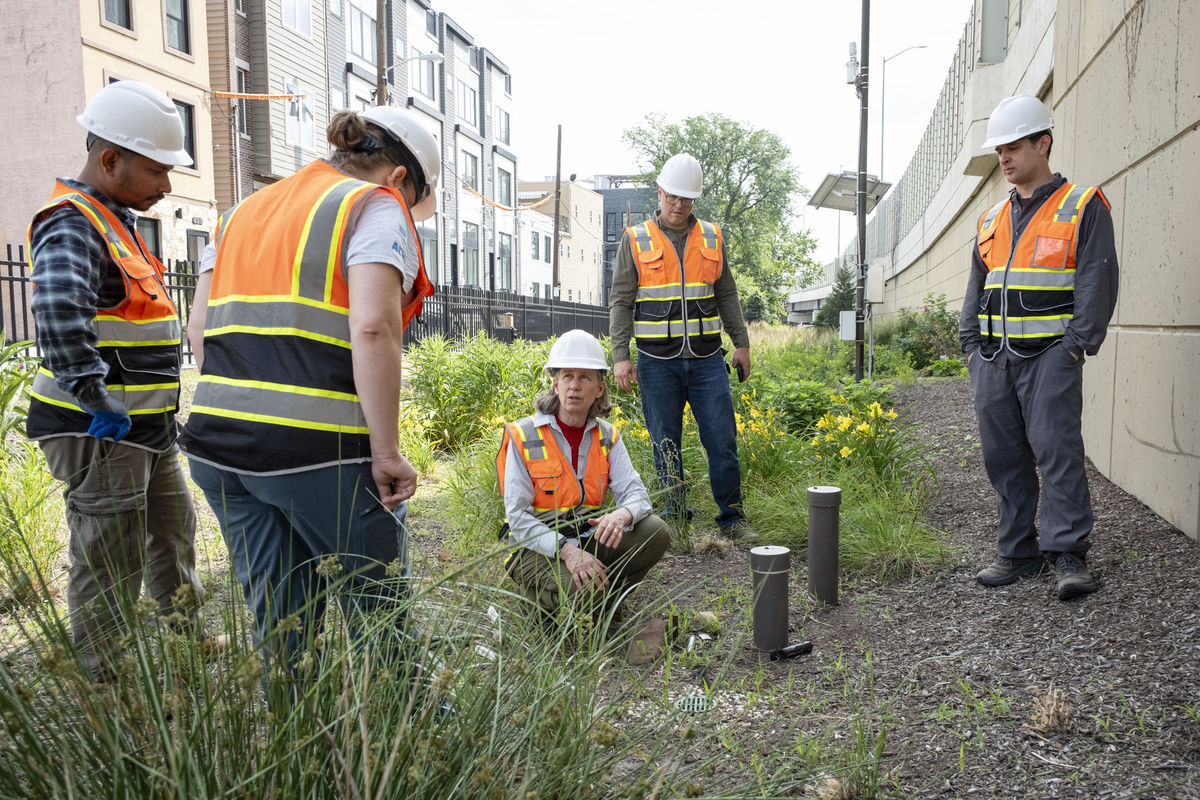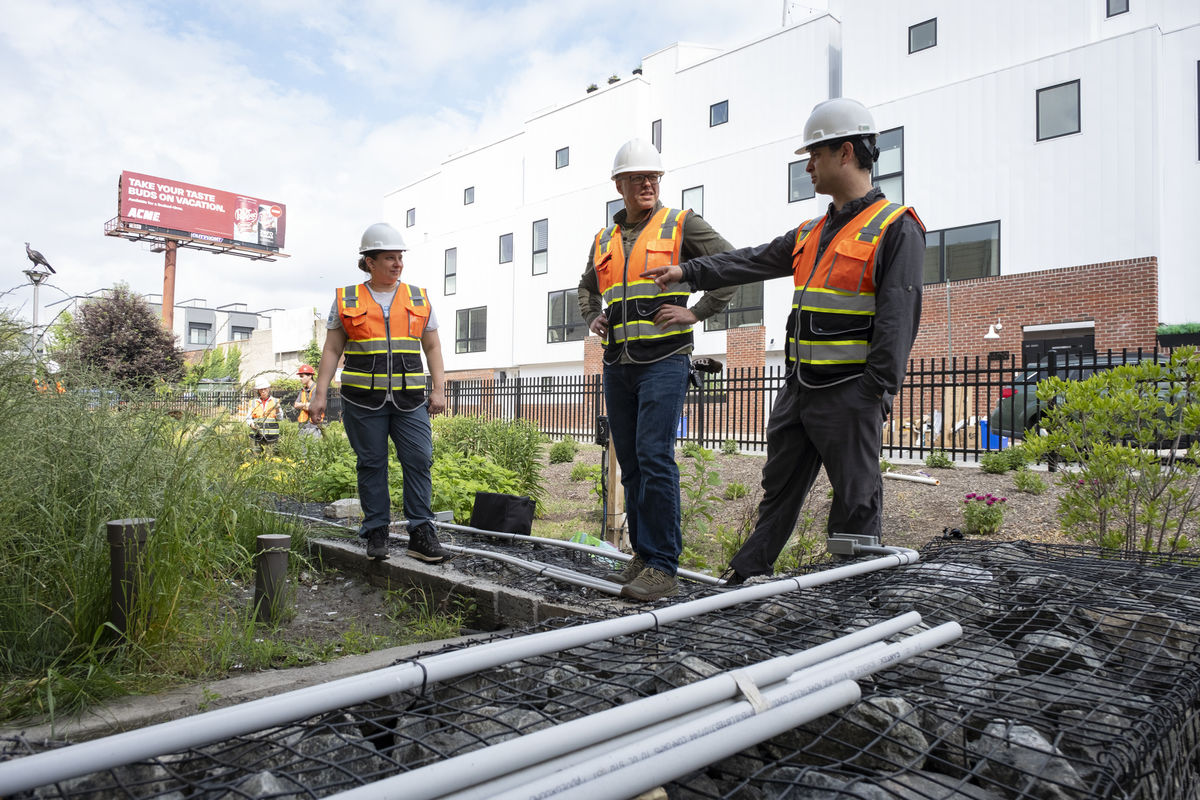Temple faculty hope to save PennDOT’s plants from deadly road salt
An interdisciplinary team of researchers is investigating the impact of road salt on the plants in bioretention basins along I-95. The project aims to optimize plant health and improve stormwater management.

Motorists driving through Philadelphia may notice greenspaces, called bioretention basins, scattered along I-95. There are dozens of them, each one filled with a variety of flowering plants, grasses and trees. Yet even on an early summer day, much of the vegetation remains brown.
An interdisciplinary team of researchers from Temple and Villanova is working to fix that. The Temple group is led by Laura Toran from the College of Science and Technology (CST) and includes faculty from CST, the Tyler School of Art and Architecture, and the College of Engineering. The team was commissioned by PennDOT in 2017 to research and monitor the basins to help improve their design.
To fix the problem of dying plants, the researchers first had to identify the culprit: deicing salt used to treat roads in the winter. PennDOT uses pipes to direct water from I-95 into bioretention basins, and during heavy winters this water can become highly concentrated with salt.
Temple researchers traced sodium from the stormwater through the basin soil and into plant tissue, establishing road salt as the root cause of poor plant health. Josh Caplan, an associate professor of horticulture at Tyler, and Sasha Eisenman, chair of Tyler’s Architecture and Environmental Design Department, then investigated why some plants were doing better than others in this challenging environment.
The researchers recently presented some of their findings in a new paper authored by Caplan, Eisenman, Associate Professor of Civil and Environmental Engineering Erica McKenzie, former engineering graduate student Ali Behbahani and former Tyler adjunct faculty member Allyson Salisbury.
Published in the Journal of Environmental Management, the research finds that plant health is heavily influenced by exposure to salt, which depends on seasonal weather patterns, location within the basin and aspects of the plants themselves. In fact, so many variables influence plant health that rather than try to address them one at a time, the researchers are recommending that PennDOT simply fill bioretention basins with highly salt-tolerant plants.

Laura Toran (kneeling center) is a hydrogeologist and faculty member at the College of Science and Technology. She is overseeing the Temple research team, which includes faculty from three different schools and colleges. (Photography by Joseph V. Labolito)
Plants are the most visible component in bioretention basins, so their health is important for aesthetic reasons. But the basins and their plants also play a key role in the city’s stormwater management.
Caplan explained that over time, Philadelphia has become increasingly covered in pavement, rooftops and other impervious surfaces. Water rushes across these surfaces rather than soaking into the earth, and the resulting deluge can overwhelm Philadelphia’s combined stormwater-sewer system.
“Any time the capacity of that system is exceeded, the surplus sewage-stormwater mixture is unable to enter water treatment plants and instead gets directed into waterways like the Delaware and Schuylkill rivers,” Caplan said. “These basins provide little pockets throughout the city where, when rain falls from the sky, it gets trapped and is allowed to slowly soak into the ground. They counteract the effect of cities having so many impervious surfaces.”
For seven years, Caplan and Eisenman have been gathering data from bioretention basins in Philadelphia’s Fishtown neighborhood. They're tracking how many plants survive the winter each year and studying changes to the plants’ morphology and physiology, which demonstrate how salt affects them.
Caplan and Eisenman quickly noticed that salt tolerance goes a long way in helping plants survive conditions in the basins. But salt tolerance in plants, Caplan explained, isn’t straightforward.
“Salt tolerance isn’t a yes or no thing,” he said, adding that plants have different mechanisms to deal with salt, and their ability to manifest these mechanisms varies with factors such as age.
“There's really a range of salt tolerance in plants, but that’s not how people talk about it. Nurseries classify plants as salt-tolerant or not salt-tolerant,” Caplan continued. “There are many different kinds of plants that are supposed to be salt-tolerant, but does that mean they can handle these basins?”
There aren’t even many relevant scientific studies that measure the varying degree of salt tolerance in landscape plants, so Caplan and Eisenman are collecting the data themselves.
In 2022, PennDOT renovated a Fishtown basin that was damaged and not draining properly. Caplan and Eisenman worked with PennDOT to incorporate a test of salt-tolerant species into the redesign like hardy hibiscus and seaside goldenrod. In total, 13 species were planted in rows, allowing researchers to test the species’ salt tolerance under varying circumstances found within bioretention basins.

Sasha Eisenman (center) is the chair of Tyler’s Architecture and Environmental Design Department, and Josh Caplan (right) is an associate professor from the department. Together, they are leading Temple’s plant and soil research for the project. (Photography by Joseph V. Labolito)
Caplan and Eisenman, with adjunct researcher Joni Baumgarten and Professor of Earth and Environmental Sciences Jonathan Nyquist, are now gathering data on survival, growth and leaf chlorophyll content for more than 450 salt-tolerant plants. Their work is ongoing, and in the coming months the data they gather will help them understand which plants are best suited for bioretention basins.
The researchers hope the new data, along with the findings in the recently published paper, will help PennDOT build basins that are better optimized for their role in managing the city’s stormwater.
The research and its implications may spread much further than Philadelphia. The chief engineer of Oslo, Norway’s, Agency for Water and Wastewater recently asked Caplan to share the published paper. Toran and Caplan say planners, engineers and landscape architects around the world can benefit from the work being conducted in Philadelphia.
“Putting green infrastructure in a city where you’ve already built your buildings is hard, and that’s why people are looking at what we’re doing here,” Toran said.
“Many cities around the world have the same kinds of stormwater problems that we have here,” Caplan added. “Philadelphia is on the leading edge of using green stormwater technology to deal with it, but people are pushing that edge forward in different ways in different places so we’re all trying to learn from each other.”


